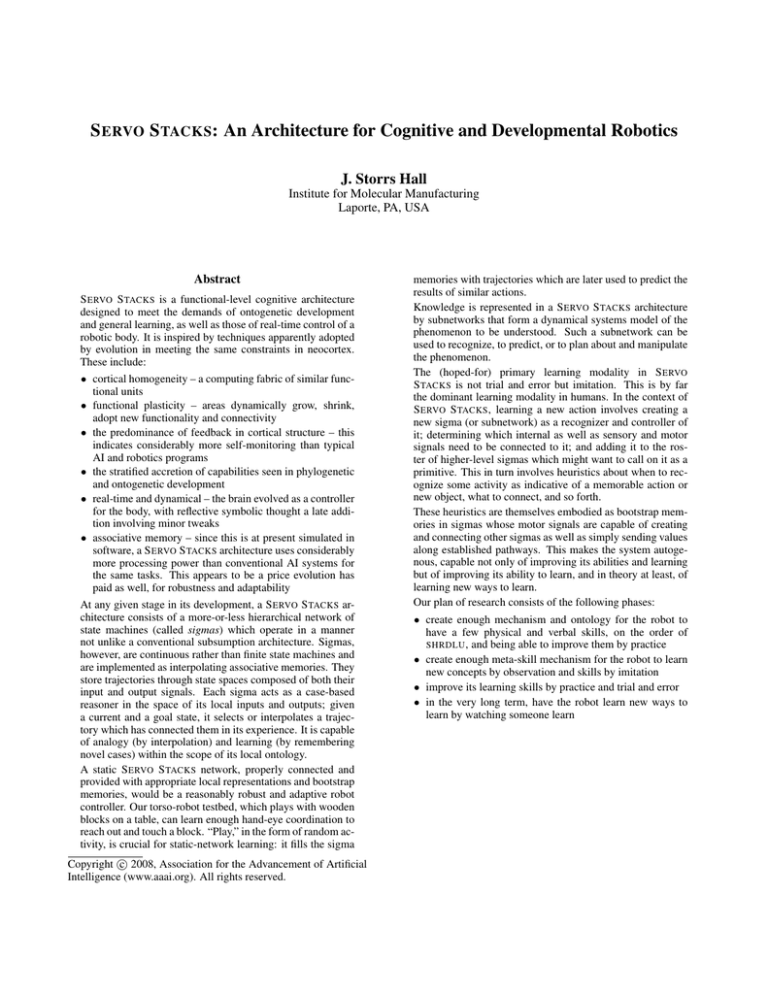
S ERVO S TACKS: An Architecture for Cognitive and Developmental Robotics
J. Storrs Hall
Institute for Molecular Manufacturing
Laporte, PA, USA
Abstract
S ERVO S TACKS is a functional-level cognitive architecture
designed to meet the demands of ontogenetic development
and general learning, as well as those of real-time control of a
robotic body. It is inspired by techniques apparently adopted
by evolution in meeting the same constraints in neocortex.
These include:
• cortical homogeneity – a computing fabric of similar functional units
• functional plasticity – areas dynamically grow, shrink,
adopt new functionality and connectivity
• the predominance of feedback in cortical structure – this
indicates considerably more self-monitoring than typical
AI and robotics programs
• the stratified accretion of capabilities seen in phylogenetic
and ontogenetic development
• real-time and dynamical – the brain evolved as a controller
for the body, with reflective symbolic thought a late addition involving minor tweaks
• associative memory – since this is at present simulated in
software, a S ERVO S TACKS architecture uses considerably
more processing power than conventional AI systems for
the same tasks. This appears to be a price evolution has
paid as well, for robustness and adaptability
At any given stage in its development, a S ERVO S TACKS architecture consists of a more-or-less hierarchical network of
state machines (called sigmas) which operate in a manner
not unlike a conventional subsumption architecture. Sigmas,
however, are continuous rather than finite state machines and
are implemented as interpolating associative memories. They
store trajectories through state spaces composed of both their
input and output signals. Each sigma acts as a case-based
reasoner in the space of its local inputs and outputs; given
a current and a goal state, it selects or interpolates a trajectory which has connected them in its experience. It is capable
of analogy (by interpolation) and learning (by remembering
novel cases) within the scope of its local ontology.
A static S ERVO S TACKS network, properly connected and
provided with appropriate local representations and bootstrap
memories, would be a reasonably robust and adaptive robot
controller. Our torso-robot testbed, which plays with wooden
blocks on a table, can learn enough hand-eye coordination to
reach out and touch a block. “Play,” in the form of random activity, is crucial for static-network learning: it fills the sigma
c 2008, Association for the Advancement of Artificial
Copyright Intelligence (www.aaai.org). All rights reserved.
memories with trajectories which are later used to predict the
results of similar actions.
Knowledge is represented in a S ERVO S TACKS architecture
by subnetworks that form a dynamical systems model of the
phenomenon to be understood. Such a subnetwork can be
used to recognize, to predict, or to plan about and manipulate
the phenomenon.
The (hoped-for) primary learning modality in S ERVO
S TACKS is not trial and error but imitation. This is by far
the dominant learning modality in humans. In the context of
S ERVO S TACKS , learning a new action involves creating a
new sigma (or subnetwork) as a recognizer and controller of
it; determining which internal as well as sensory and motor
signals need to be connected to it; and adding it to the roster of higher-level sigmas which might want to call on it as a
primitive. This in turn involves heuristics about when to recognize some activity as indicative of a memorable action or
new object, what to connect, and so forth.
These heuristics are themselves embodied as bootstrap memories in sigmas whose motor signals are capable of creating
and connecting other sigmas as well as simply sending values
along established pathways. This makes the system autogenous, capable not only of improving its abilities and learning
but of improving its ability to learn, and in theory at least, of
learning new ways to learn.
Our plan of research consists of the following phases:
• create enough mechanism and ontology for the robot to
have a few physical and verbal skills, on the order of
SHRDLU , and being able to improve them by practice
• create enough meta-skill mechanism for the robot to learn
new concepts by observation and skills by imitation
• improve its learning skills by practice and trial and error
• in the very long term, have the robot learn new ways to
learn by watching someone learn








